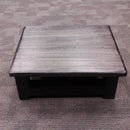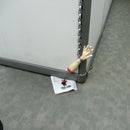Introduction: Oil Change - a New Approach
Now I'll preface this instructable by saying that this is not a new way to change oil but rather a new method to myself and I think its worth sharing. With a first glance around instructables I don't see anyone else covering the oil extractor oil change so I'm going to. I think it's a novel concept and allows automotive repair shy people a chance to do their own oil changes with very little in the way of necessary tools.
Note: if your oil filter is not easy to reach by either reaching your arm under the car or coming through the top of the engine bay this method may not be for you.
The heart of the beast is the oil extractor. The traditional method of an oil change requires you have a high enough car or to jack it up to reach the oil pan bolt on the underside of your vehicle. From there you loosen the bolt and let the oil drain. Replace the crush washer and tighten the bolt and refill the oil. I don't own a jack that I would trust my body to go under a car with and my car is really low so that was an instant put off.
Enter the oil extractor - a pneumatic tool that sucks the oil out of the engine through the dipstick hole.. You charge a canister to contain a vacuum and insert a tube down the dipstick hole. Once the tube hits the bottom of the pan you can release the vacuum and have the oil sucked right up into a portable container.
This method greatly simplifies and decreases the chance for error in the oil change process.
Lets begin with what tools you will need:
-Oil extractor - http://www.amazon.com/America-5060-Topsider-Multi...
I chose this extractor because of the all metal design. This can come in handy if you accidentally over pump your container. If you over pump it, you can actually implode your canister. I saw that this was a bigger problem with some of the plastic types, but get whatever one you want.
-New oil (consult your manual)
-Filter : at any auto parts store they will have a book you can look up your year and model and find the correct filter to use on your car. Or just ask someone there. I have found auto parts store employees to be very friendly.
-Filter wrench: I use something that looks like a giant socket. It fits over the end of the filter and grabs on allowing to remove the old stubborn filter from the car. There are a ton of different ways to remove a filter though. They have these large pliers, rubber loops wrench, sockets (like mine) and sometimes filters have a nut on the top you can use a regular old socket set to get off. Again check out your situation (i'll show you later) and see what will best fit you.
-Oil catch pan : some oil will still drop out of the filter when removing it so have an oil catch pan on the ready to catch those drips and whatever is left over in the old filter
-Funnel (optional) : if you have steady hands you don't need a funnel else wise by a funnel. they're cheap and worth it for filling the engine back up with oil.
Step 1: Warm Up
We want to extract oil while it is warm, not hot. If you just came back from the auto parts store, let that car sit for a good half hour or more. It's incredible how hot oil gets and don't want to burn yourself. If your car has been sitting for a while, start it up and let it run for 5-10 minutes. The key here is we don't want the oil to get to operating temperature but warm enough to flow easily.
Step 2: Prepare the Oil Extractor
While the car is warming up or while you are waiting for the car to cool down, assemble your oil extractor unit. Usually this just involves screwing on some caps and gaskets and connecting some tubing. The instructions that came with my unit were detailed and it was easy to put together.
Once the unit is assembled you will have to operate a hand pump to form a vacuum in your canister. For my unit this means pumping 35-40 times to achieve the proper vacuum. Make sure your tube is crimped, using the plastic crimper, so to avoid any passing air.
For a comprehensive video on this method of oil change, how this topsider extractor works and more check this video out:
Step 3: Start Extracting
When your car has reached a safe temperature remove your dipstick and place it to the side. Make sure to wrap it in a clean bunch of paper towels to avoid dirt.
Start feeding the extraction tube down the dipstick hole. At some point you will get resistance. Try shoving a little further. Sometimes the hose gets trapped in a curve and will continue on a little further. If it does not give way you have reached the bottom of your oil pan.
Undue the crimper on the tubing and you will begin to see oil coming up and out of your engine and into your canister.
Depending on the amount of oil your engine takes this could take a 10-20 minutes. You'll know the extractor is done working because air bubbles will start coming up the tube and it will make a sound like you are finishing a soda through a straw.
Usually at this point, I will recharge the vacuum and try a few more times just to get as much oil as possible out. I'm not sure that it helps because I seem to only get a few ounces at the most but it makes me feel better.
I've done my research on this topic and the extraction method is just as good, if not better, than the standard oil bolt method. There will be oil left in the pan no matter which method you use.
https://www.youtube.com/watch?v=z-Z7bcR1DQM&feature=youtu.be
Step 4: Remove Old Filter
While the oil is extracting you can make your way to your oil filter. The location of this varies from vehicle. The "test" vehicle I'm working on in the pictures is a 2012 Nissan Versa and its on the bottom of the engine just beyond the front bumper. A very easy filter to get to. Another example is my 2003 MINI Cooper which has an oil-canister on the top of the engine near the back of the engine bay. Each car is different. If you can't find your oil filter, consult your manual or Google your make and model to find out it's location in the engine bay.
I am using an oil filter socket to take off my filter. It connects to a standard socket wrench/breaker bar. The socket slips over the oil filter and you can start unscrewing it. Some times those factory or oil change places crank the hell out of those filters so it may take some elbow grease to get it off. Also working in an awkward laying down position can hinder any kind of leverage but it is doable.
While the oil is draining just get the filter loose and nothing more. You do not want any oil spilling out of the filter yet.
Step 5: Remove Oil Filter Pt 2
Once the oil is finished being sucked out we can take the filter all the way off. Get your oil pan under the car and right under where the oil filter is coming off. Unscrew the oil filter all the way and let it drain into the pan.
Take your new filter out of the box and ,using your pinky finger, dab a little used or new oil on the gasket and start screwing the new filter onto the engine.
Snug the oil filter by hand. As hard as you can get it on by hand is about the torque needed to seat it properly. If you are really paranoid, buy a torque wrench. But hand snugness is a widely accepted form of tightening.
Step 6: Adding New Oil
Take the oil cap off and insert your funnel into the opening. Using your manual as a guide add about a half quart less than it says to add. We can always add more later. It's always easier to add more oil than having to suck out too much.
After adding the oil replace the oil cap and put in your dipstick. Hop in the car and start up the car. Allow the car to run for a few minutes. We want all cavities to fill up with oil. After a few minutes turn the car off and let sit for another couple of minutes to let everything settle. Remove your dipstick and check your levels. If you need more add a little more at a time.
When you are satisfied with the level put the dipstick back in and consider yourself done!
Step 7: Recycle That Oil
The same place you bought your motor oil should also be the same place to accept used motor oil. Don't throw oil out or dump it on the ground. Take it in to get recycled. Some places even take the used oil filters.
You have a nice carry container now when you use the extractor. No dirty hands!

Participated in the
Teach It! Contest Sponsored by Dremel

Participated in the
Fix & Repair Contest











